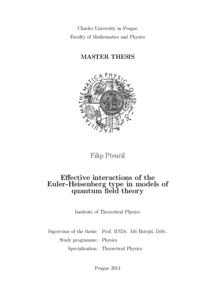Effective interactions of the Euler-Heisenberg type in models of quantum field theory
Efektivní interakce Euler-Heisenbergova typu v modelech kvantové teorie pole
diploma thesis (DEFENDED)

View/Open
Permanent link
http://hdl.handle.net/20.500.11956/64422Identifiers
Study Information System: 123071
Collections
- Kvalifikační práce [11325]
Author
Advisor
Consultant
Novotný, Jiří
Referee
Kampf, Karol
Faculty / Institute
Faculty of Mathematics and Physics
Discipline
Theoretical Physics
Department
Institute of Particle and Nuclear Physics
Date of defense
10. 9. 2014
Publisher
Univerzita Karlova, Matematicko-fyzikální fakultaLanguage
English
Grade
Excellent
Keywords (Czech)
efektivní teorie, rozptyl světla na světle, kvantová elektrodynamika, standardní modelKeywords (English)
effective theories, light by light scattering, quantum electrodynamics, standard modelV předložené práci studujeme rozptyl světla na světle, což je nelineární efekt objevující se v kvantové elektrodynamice (QED). Cílem práce je studovat nízkoenergetickou efektivní teorii (lagrangiány Euler- Heisenbergova typu). První část práce je věnována odvození efektivního lagrangiánu ve spinorové, skalární a vektorové QED pomocí přímého fitování amplitud jednosmyčkových diagramů. Výpočet pro případ vektorové QED je proveden s použitím unitární kalibrace, což pravděpodobně zatím nebylo zpracováno žádným jiným autorem. Ve druhé části je efektivní lagrangián pro spinorovou QED odvozen pomocí funkcionálních metod. Podstatný bod odvození je spočtení determinantu Diracova operátoru v přítomnosti konstantního pozaďového elektromagnetického pole. Powered by TCPDF (www.tcpdf.org)
In the present thesis we study light-light scattering, which is a nonlinear effect occurring in quantum electrodynamics. The goal of this thesis is to study the low-energy effective theory (Lagrangians of Euler-Heisenberg type). The first part of the work is devoted to the derivation of the effective Lagrangian in spinor, scalar and vector QED using the amplitude matching of one-loop diagrams. The calculation for the case of vector QED is performed using the unitary gauge, which probably has not been done yet so far by other authors. In the second part, the effective Lagrangian for spinor QED is derived using functional methods. The essential point of the derivation is to calculate the determinant of the Dirac operator in constant background electromagnetic field. Powered by TCPDF (www.tcpdf.org)
